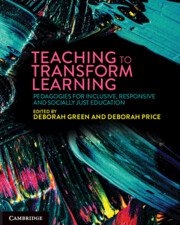Book contents
- Teaching to Transform Learning
- Acknowledgement of Country
- Teaching to Transform Learning
- Copyright page
- Contents
- Contributors
- Acknowledgements
- Introduction Understanding the learner to inform educators’ implementation of pedagogical approaches to transform learning
- Part 1 Pedagogies for all
- Part 2 Engaging pedagogies: making the curriculum come alive for all learners
- 8 Redesigning pedagogy for transformation: creative body-based learning
- 9 Building transformative classrooms through visual and creative body-based learning design
- 10 Co-constructed early childhood pedagogies
- 11 Strengths-based, learner-centred pedagogies: the voice of learners in co-creation and co-design
- 12 Pedagogy informed by community expertise
- 13 Nature-based approaches enhancing experiential learning
- 14 Beyond the four walls
- Part 3 Empowering pedagogies: 21st-century skill development and 22nd-century futures thinking
- Index
- References
14 - Beyond the four walls
from Part 2 - Engaging pedagogies: making the curriculum come alive for all learners
Published online by Cambridge University Press: 25 October 2024
- Teaching to Transform Learning
- Acknowledgement of Country
- Teaching to Transform Learning
- Copyright page
- Contents
- Contributors
- Acknowledgements
- Introduction Understanding the learner to inform educators’ implementation of pedagogical approaches to transform learning
- Part 1 Pedagogies for all
- Part 2 Engaging pedagogies: making the curriculum come alive for all learners
- 8 Redesigning pedagogy for transformation: creative body-based learning
- 9 Building transformative classrooms through visual and creative body-based learning design
- 10 Co-constructed early childhood pedagogies
- 11 Strengths-based, learner-centred pedagogies: the voice of learners in co-creation and co-design
- 12 Pedagogy informed by community expertise
- 13 Nature-based approaches enhancing experiential learning
- 14 Beyond the four walls
- Part 3 Empowering pedagogies: 21st-century skill development and 22nd-century futures thinking
- Index
- References
Summary
In today’s complex world, we know as educators that learning is most meaningful when established through experience – learning by doing rather than by simply listening or observing. Our learners need to be supported in nurturing their creativity, developing as critical thinkers and flexible problem solvers, to apply skills and understanding in new domains and different situations creating solutions to problems encountered. Education and life should not be isolated from each other. By providing opportunities for learners to engage and learn through authentic, real-life, relevant experiences, we are scaffolding their application of skills to learning including adapting and changing their ideas and forming habits of lifelong learners. This chapter provides educators with a guide for embedding cross-curricular exploratory learning experiences as an integral part of planning, teaching and assessment responsive to all learners; and inclusive of the theoretical foundations and instructional strategies that inform their approaches. Authentic studies will be utilised, and practical tools outlined, to demonstrate how to bring these concepts to life within a constructivist framework.
Keywords
- Type
- Chapter
- Information
- Teaching to Transform LearningPedagogies for Inclusive, Responsive and Socially Just Education, pp. 219 - 240Publisher: Cambridge University PressPrint publication year: 2024

